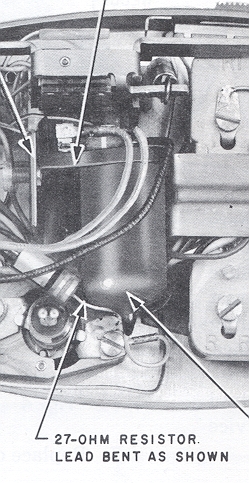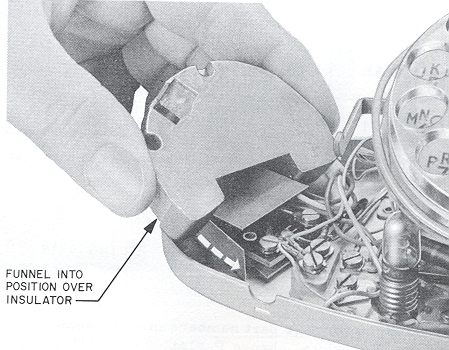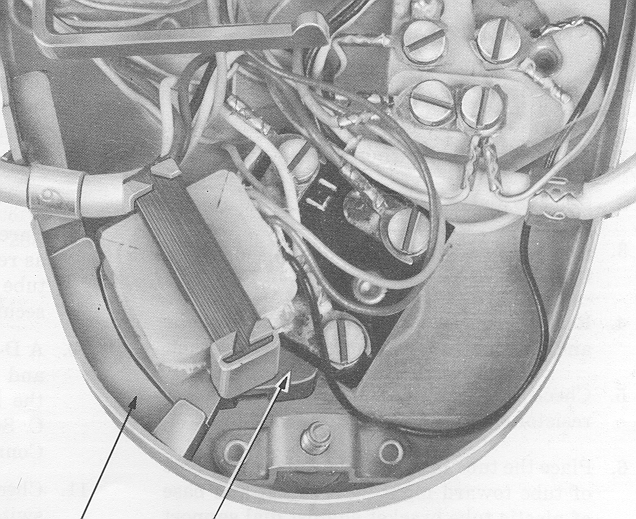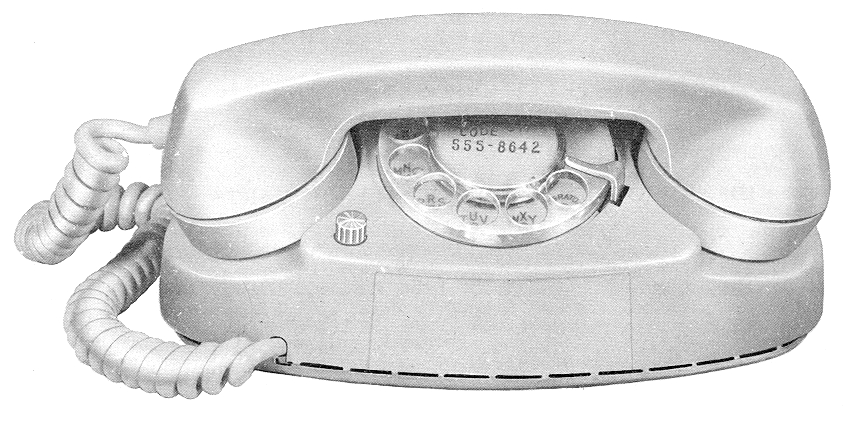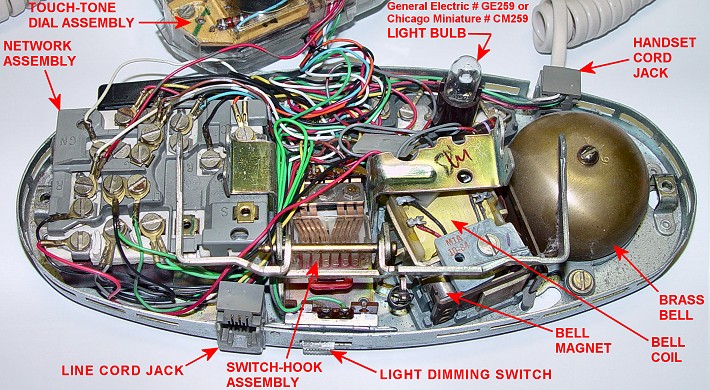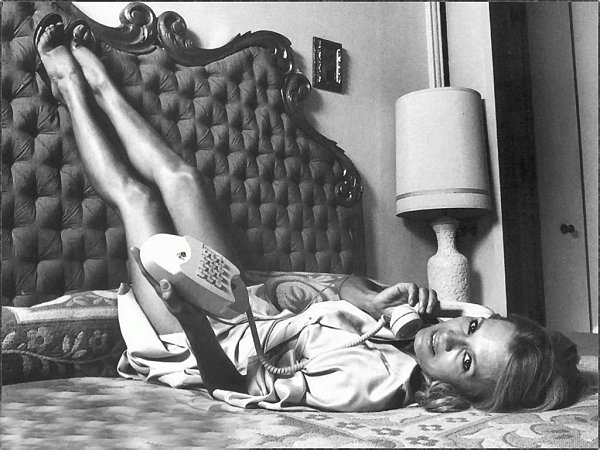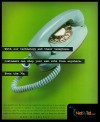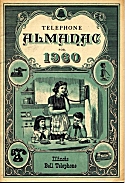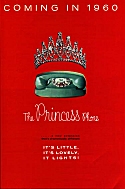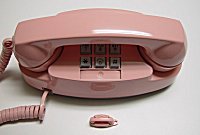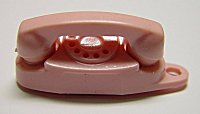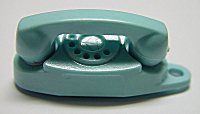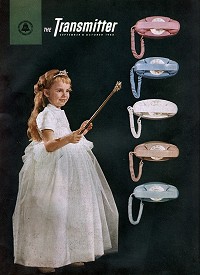
Western Electric Products- The Princess Phone
Sewing Machine - Automatic Answering Service “Mirrophone” wire ribbon recorder/player Telephones - PicturePhone - Bell Chime
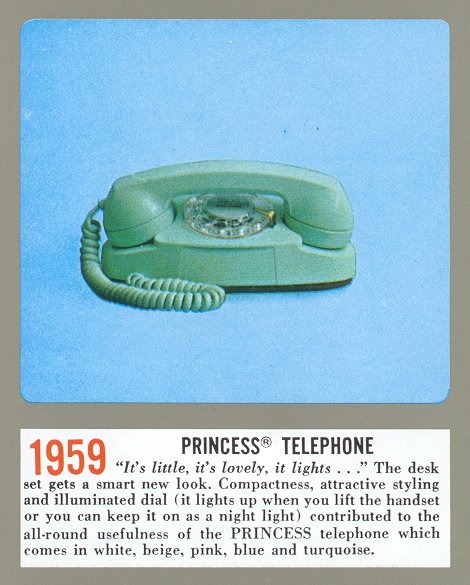
From AT&T’s " The Telephone Story" poster.
Princess is a registered trade mark of AT&T.

We Offer Personalized One-On-One Service!
Call Us Today at (651) 787-DIAL (3425)


“It’s little, it’s lovely, it lights . . . “ was the marketing slogan of one of the most popular telephones among collectors of Western Electric phones today - the Princess phone. This page will provide you with both historical and technical information on this phone. The Princess phone is one of my favorites!
- Schematics (only a few have been scanned and made available so far):
To download the entire 2702 section in PDF format, click here.
Some of the next Princess models listed (some are two-line models) have not been scanned yet but will be upon request:
-
701B - (from another BSP)
-
701 and 711 (from another BSP, section c38.6700.00)
-
712B
-
2712B
-
712BM and 2712BM - Click on either GIF format or PDF format
-
713B and 713BM (PDF format) (or GIF format: 713BM page 4, 5, 6, 7, 8)
-
2702D and 2702DM
-
2713B and 2713BM
-
2750A, 27508, 2750AM, 2750BM, 2750AMG, and 2750BMG
-
751-Type
-
2751-Type
-
753A and B
-
2753A and B
A SPECIAL NOTE TO THOSE THAT CAN’T GET THEIR PRINCESS PHONE TO LIGHT:
The older modular Princess phones (prior to the mid 1980’s) require a special transformer AND special modular adapter plug to prevent the transformer voltage from being injected on the second pair of wires (reserved for a second phone line). The modular plug from the Princess line cord plugs into the jack on the adapter labeled “PHONE” and the transformer modular plug mates with the jack on the adapter labeled “POWER” as seen in this photo. For the non-modular Princess phones (generally made prior to the early 1970’s) the transformer was hardwired with no adapter as seen here.
There is a genuine Western Electric 2012C transformer ( view of terminals side ) included along with an after-market adapter and line cord.
So how can you tell if your Princess has the lamp (or at least a socket for a bulb)? Click HERE and note the round plastic “twist-lock” lamp holder identified in the photo. If you don’t see this on the bottom of your Princess telephone, then you have one of the newer (and cheaper) “Signature” series phones from AT&T.
The " CS” prefix on some Princess phones made in the early to mid 80’s may or may not have the lamp. Look at the bottom of the phone and see if there is a plastic** **lamp holder socket present. (Photos courtesy of Ray Marks.)
The Princess uses the Western Electric 2012A or 2012C transformer as described in the ATCA newsletter article below. The line cord going to the Princess phone MUST be a 4 conductor cord (usually has red, green, black and yellow wires inside the cord). Inside the Princess you will need to connect the red and green wires to L1 and L2 on the network and the black and yellow (black and white on a 5 conductor cord) to the terminals labeled 3 and 4 inside the phone. The black and yellow wires on the opposite end of the cord must then be connected, either directly or indirectly through a special adapter plug, to the two contacts on the transformer.
The special modular adapter plugkeeps the current from flowing back into the telephone jack in the wall and jumpers the two black and yellow conductors together in thespecial modular adapter plug****. Plug a modular-to-spade cord using only the black and yellow as spaded ends on one side into one port of the modified adapter from 2012A or C transformer. The 4-conductor cord into the Princess phone allows telephone line connections on the red and green wires and transformer power leads on black and yellow.
**WARNING!IF YOU HAVE A PRINCESS TRANSFORMER MADE BY AULT, IMMEDIATELY REMOVE IT FROM YOUR POWER OUTLET AND DISCARD IT. IT WAS RECALLED BY THE MANUFACTURER (AULT) AND SHOULD BE REPLACED WITH A NON-AULT BRAND TRANSFORMER.HERE**IS THE BELL SYSTEM PRACTICE DOCUMENT WITH MORE DETAILS.
Contents of this page:
-
[Photos of wire connection locations](#702B line cord and bulb connections) for major components of a model 702 with 4228F network.
-
[Photos of original line cord connections](#702B line cord and bulb connections) of model 702B
-
Photo showing yellow and black wire connections from modular line cord socked to the lamp assembly screw terminals.
-
Photos of a VERY RARE clear Princess phone (courtesy of Wally Tubbs who was lucky enough to get his hands on one!)
-
[Princess phone history](#ATCA article) and technical information as written by Jay Neale for the ATCA newsletter of November 1999
-
[The First Touch-Tone Princess](#The First Touch-Tone Princess) had only 10 buttons
-
[1962 Seattle - World’s Fair Princess phone display model](#Seattle World’s Fair)
-
[My personal historical summary](#Now another historical look) of the Princess phone
-
[Classic AT&T Princess phone](#AT&T history article on Princess phone) and history of the original Princess phone - by AT&T
-
[Often imitated, never duplicated](#Often imitated, never duplicated) - Competitor’s models similar to the Princess
-
[Princess phone in Disney’s “Toy Story 2” movie](#Princess phone in Disney’s “Toy Story 2”)
-
Princess schematics, advertisements and miscellaneous other things relating to the Princess phone
-
The Princess is announced in the cover story in the September/October 1960 issue of [The Transmitter](#The Transmitter)” magazine.
-
Trial installation documentation - Thanks to Gary Goff for this document scan.
-
[Keychain Princess telephone “charm”](#Keychain Princess)advertising give-away; an original 1959 Bell System Promo
Photos of wire connections - Model 702 with 4228F network
I took apart an old rusty Princess 702 model to make the following photos. I hope these images will help you determine if your Princess is wired correctly.
Photos of line cord and lamp wiring - Model 702B with 4010 network
-
Overall view of my Princess model 702B (made in 1970) with original five-conductor line cord.
-
Close-up photo of spade terminals on line cord wires that would connect to a wall-mounted terminal block in the days prior to the introduction of the modular plug and jack (RJ-11).
-
Photo showing other end of line cord where wires go to the various terminal screws inside of the phone.
-
Photo showing original Western Electric line cord attached to base of telephone using the already installed strain-relief (mounting) hook.
-
And while we’re at it, here is how the original hard-wired handset cord mounts to the base.
-
Top view of 4010B Network
"…It’s Little. It’s Lovely. It Lights!" - by Jay Neale
This month I find myself looking forty in the eye and wondering what’s on the other side. I know it will be more of the same but I’m sure adventures lay ahead. I made my debut in the tail end of the fifties; just long enough to say I was there. I was this pink oval thing with a cord and yet I wasn’t alone. For just a few months prior another pink oval thing made its debut - the Princess phone. Actually its gestation period was a little longer than mine but in the end we found ourselves in the world together. What better subject to cover this month?
Origins
The roots of the Princess phone date back to 1955 when Bartlett Miller was appointed to head a new department in Bell’s Merchandizing Department. He believed that the Bell System had done a good job providing the customer with what they needed - but weren’t listening to what they wanted. In essence he brought the concept of market research to the forefront. The world was changing; conveniences were becoming commonplace and people wanted more than just the main phone in the hallway. They wanted a phone that would fit on a bedside table; they wanted their teenagers out of the main hall too!. Miller realized this potential market and went after it. In 1956 Henry Dreyfuss was commissioned to design this new set and by the end of that year field trials had begun. The resulting set hinted at the oval of the 202 D1 Base desk station. However this set included the network components. More importantly a light was provided to act as a bedside night light and an aid to dialing in the middle of the night.
Evolution
Several versions evolved from the basic 701 model to include message waiting lamp, two line options, secretarial service, exclusion and hold features. The rotary dial was present on the original model followed by the 10 button touch tone and then the 12 button touch-tone pad. The original 701 sets didn’t have room for a standard ringer so an E1 ringer was wall mounted as an adjunct. The resulting set was a full 3 pounds lighter than the 500 desk sets - so light in fact that a weight was later added to keep the phone from spinning during dialing and falling off the table on the slightest tug. This practice ended in 1963 when the M1A ringer was developed. It fit snugly into the base and set from that point on were designated 702. In the later model 702, the M1A ringer was replaced by the P1A ** **ringer, the same ringer found in the Trimline model. The mid seventies modularized the Princess. Sets were not only manufactured modular, they were also retrofitted in the field. During a brief period in the early eighties a CS version was sold to customers through the Phone Center stores. They didn’t trust the customer to figure out how to get the light to work so they removed it altogether. This was followed by the Signature Princess. It was only leased by AT&T and had a line powered dial, was tone pulse switchable and had volume control The night light feature still required an external transformer. Rumor has it that these phones ended their production run in 1994. I’ve also heard that some Princesses are still being leased by the public - if you know for sure let me know.
The 701 model contained a 495 network. This network was replaced by the 4010 network in the early 702 models and the 4010 network was later replaced by the 4228 network.
**Shedding Light on the Lamp*8
The early production Princess phone used a screw-base number 46 lamp whereas the later production Princess phones used a wedge-base number 259 lamp.
Either of the two number 259 wedge-base bulbs listed below are direct replacements for the wedge-base bulb found in the later production models of the Princess phone::
General Electric #GE259
Chicago Miniature #CM259
The light bulbs are available from:
- Mouser Electronics - USA www.mouser.com
(800) 346-6873
Open 7AM - 8PM (CTZ) Monday-Friday
Mouser Stock #606-CM259
- Chicago Miniature Incandescent Lamp - T-3 ¼ WDG 6.3V .25 CM259
They were 51 cents each or 45 cents each for 10 last time I checked. They have NO minimum order (rare these days!) They have three locations; one in Santee, California, another in Mansfield, Texas, and the third in Randolph, New Jersey.
Mouser also carries the older style screw-base bulb, number 46, for less than a dollar each. The Mouser part number for the number 46 screw-base bulb is 606-CM46.
LAMP INSTALLATION IN A 711B
The lamp circuit makes use of the black and yellow conductors in standard station wire. Its powered by a small transformer that plugs into an outlet. The lamp itself is a small screw bulb that could be replace by the customer - yes you heard me right, the customer was actually able to make a repair. Access to the bulb was made by turning and removing the socket from the bottom of the phone. The slot in the lamp base was curved to best fit a coin so that no real tools would be required. A switch in the circuit at the rear of the phone let the customer turn off the night light.
Webmaster’s Note: Later models of the Western Electric Princess phone did not use a screw type base but rather a wedge type base. See my photo of the new socket and lamp style.
GAS TUBE INDICATED BY ARROW ON RIGHT
In night light mode current passes through a dropping resistor to dim the bulb. Contacts in the hookswitch bypass the resistor to provide full illumination for dialing when the handset was picked up.
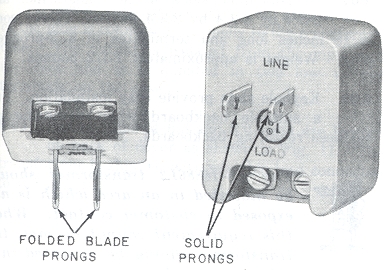
The 2012A transformer originally powered the lamp. It had solid plug blades that caused problems because it tended to fall out of wall outlets. The correct part number for the 2012A replacement is the 2012C. Both the A and C versions put out 6-8V AC. (There was also a 2012D which put out 15-18V and replaced the 2012B.) The photos in the BSP (Section 501-136-100, ISS 7) show the 2012A and B with solid prongs and the C & D versions with folded prongs.
[ Webmaster’s note: At the suggestion of one of our website visitors, here is some info on where you might be able to purchase these transformers made by AT&T as part of a kit which also includes the modular adapter and line cord. Click HERE for a view of the instruction sheet and HERE for a view of the transformer label. The kits may be obtained from Dennis Owens of Vintage Telephone Restoration. His phone number is 1-609-886-3352 (USA).]

To combat this a 2A clamp was designed and implemented to hold it firmly in place. Later the 2012C transformer fixed the problem. It had folded prong blades the held tighter and didn’t require the clamp. In the eighties a modular solution was developed. The transformer had a cord with a modular plug. This was plugged into a Y adapter designed specifically for this task. The 218 adapter turns up in modular schematics.
Inside the 701
INSERTING THE WEIGHT
While they may not have gotten a ringer into the 701 Princesses they did manage to squeeze in a bunch of stuff. The weight mentioned earlier (P15E719) came with a cardboard insulator to protect the terminal strip and a spring clip to hold it in place. These were installed at the factory and also retrofitted in the field. In some instances party line identification involved a scheme that wired the ringer from tip to ground instead of across tip and ring. It was known as “Tip Party Identification”. But without a ringer something had to be done. To solve this problem an induction coil with resistances equivalent to a ringer coil had to be added to the phone. The 1610 Inductor used a wedge to hold it in place and took the spot reserved for the weight. A 1635 inductor was later used. It had a mounting bracket and fit into the middle of the phone so that the weight could be used. You might even get lucky and find a gas tube inside. This was used for a polarity ringing scheme on party lines.
1610A INDUCTOR
Ringers
The original 701 princess required a wall mounted ringer, the 702 ushered in a M1A ringer that just fit into the small space.
Colors Choices
The original 701 princess was introduced in White, Light Beige, Aqua Blue, Turquoise, and the all time favorite Pink. Later the more common colors of Ivory, Moss Green, Red Yellow, Black and Light Grey were made.
In the late 1960s and early 1970s Gold and Clear sets could be special ordered. In the mid 1980s, Teal Blue sets were made for a short while.
In the 1990s sets were refurbished in Slate Blue, Peach and Cameo Green. The Signature Princesses were available in Pink, Light Blue White, Ivory and Peach.
Part Numbering
Its important to note that the 701 didn’t have the vent slots that the 702 did - its a quick way to spot one.
701B Original set without a ringer (see stripped base and bottom of one I have)
701D The D was for message waiting lamp
702BM The 2 designates an internal ringer, the M is for modular
1702B Ten button Touch-Tone
2702B 12 button touch-Tone
711B - Slide switch /push button, two line with exclusion
712B - Turn Key, 2 line with hold (and several other combinations)
713B - 2 line with Exclusion or hold
CS2702BM - Touch-Tone, no illumination
2703BMG - Signature Princess
702D WITH MESSAGE WAITING LAMP
Toys
Probably the most loved phone by any little girl the pink princess was often copied as toys I had to show one:
A big thanks to the listserve members who helped me!
The First Touch-Tone Princess had only 10 buttons
The first touch-tone Western Electric phones, including the Princess, had only ten buttons (there were no keys for the # or * symbol). Here are some scans of a pamphlet of a ten-button Princess (model 1702) submitted to this web site by Paul Rush (page 4 shows other 10-button Western Electric models):
Inside view of a traditional Touch-Tone model Princess telephone.
Click on image above to enlarge
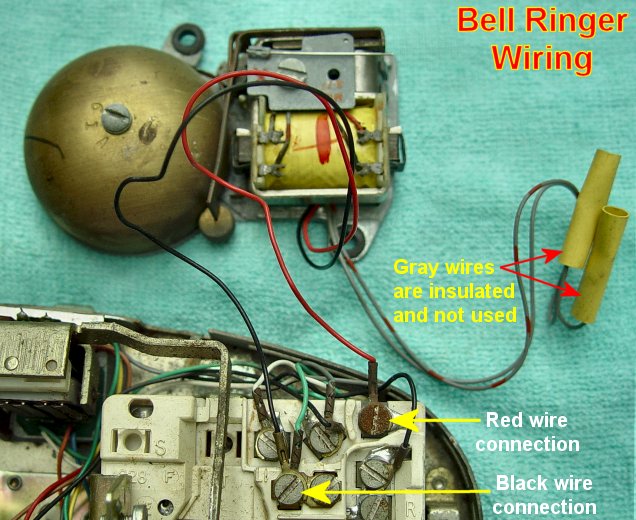
Event: Seattle World’s Fair Year: 1962
The Princess phone had only been available for a few years at the time of the fair. A non-working, smaller-than-real-life model of the phone was a souvenir from this event. They were about 10cm (4 inches) long. A real Princess is about 21.5cm (8.5 inches) long. One of these was just sold on eBay in mint condition! Here are the photos from that auction:
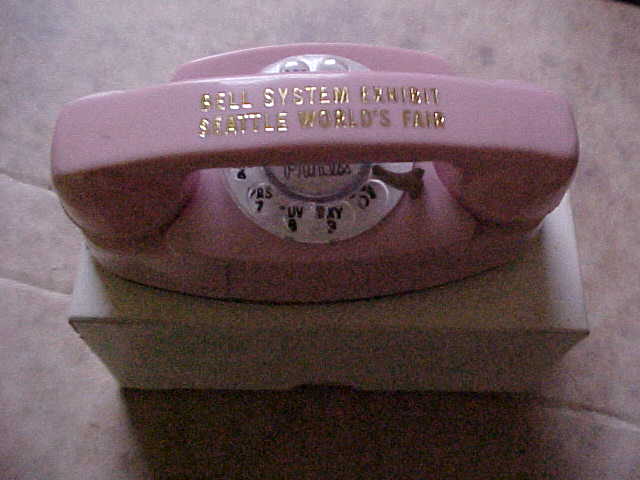
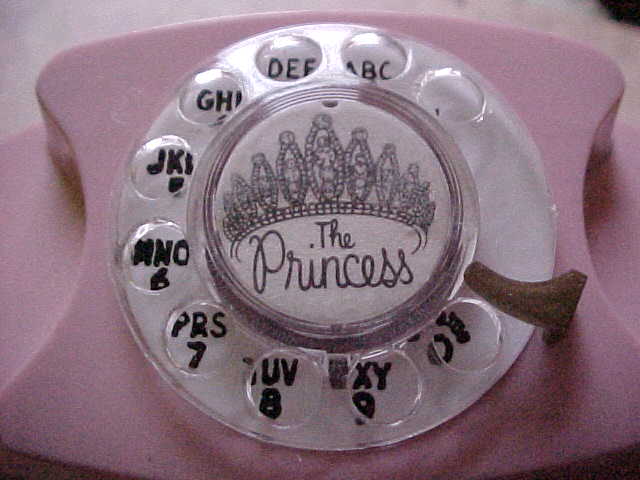
Now another historical look at the development of the Princess phone based on my research prior to the article above:
In 1955, Western Electric began work on the Princess telephone. Prior to the Princess telephone, clunky desk telephones prevailed. The Princess was designed to be a “bedroom telephone.” It was smaller and sleeker than what was known as the “ 500 set” and was lighter in weight. It had a rotary dial and no internal bell when it was first introduced to the Bell System customers. It’s name was chosen from a list of 300 suggested names. The name “Princess” was chosen for this model for its small size and decorative oval shape.
Industrial designer Henry Dreyfuss, who had assisted Bell since the early 1930’s, was asked by the Bell System to design the Princess, partly due to his very popular design of the " 500" desk set which was the “basic” phone for many decades. He worked with Bell Labs engineers and Western Electric’s Indianapolis Model Shop to create a model that was lighter and smaller–designed for use on night tables–than the standard model. The Princess had an illuminated dial, and came in five colors. The Princess was test marketed in Colorado, Georgia, Pennsylvania, and Illinois.
In 1956, he had prototyped models of the Princess which were shown to telephone subscribers in Richmond and Cleveland for their reactions to this new style. When Western completed design of the Princess, it operated two field trials, one of which was in Pennsylvania. Customer comments were highly critical. Western Electric had designed the small, oval-shaped base with all the internal equipment on the left side. According to Western, the right side was empty so new equipment that would make the Princess more versatile could be added at a later date. The uneven distribution of weight caused the set to move around the table as a subscriber tried to dial. The subscriber needed one hand to hold the base in place and the other to dial, while squeezing the handset between neck and shoulder.
Bell Labs chose to disregard the complaints and gave Western Electric the green light to manufacture the Princess sets as designed. Tens of thousands of sets went out to subscribers, and the result was thousands of disgruntled customers and thousands of calls to individual operating company repair service facilities.
Northern Electric Company (the Canadian equivalent of the United States’ Western Electric), which was producing a similar but better designed set, ran full-page ads reminding subscribers that Western Electric’s Princess was a two-piece set for three-handed people! However, a rather interesting point on Northern’s version of the princess: Early on in the production run they used a glue for the base pad that lost its adhesion when it had a couple months to cure on the shelf. As a result, the base pads fell off of the phones when they were removed from their boxes. These were commonly referred to as the “barefoot contessa”.
Finally, because of sheer customer pressure, Western produced a counterweight to be mounted on the right side of each set and thousands of repairmen made scheduled visits to retrofit the tens of thousands of Princess sets installed in the marketplace. Millions of dollars were expended because the infallible Bell Laboratories rejected their own test results.
Even though the Western Electric Princess phone was officially introduced in 1959, it wasn’t until 1963 that Bell Labs designed a ringer small enough to fit into the base of the Princess phone. Prior to 1963, the ringer was external and mounted on the wall’s baseboard.
The Princess phone requires a separate A.C. line-powered transformer to power the light inside the phone. The Trimline telephone required a wall transformers at first. The round button Trimline touch-tone model and rotary model of the same period used incandescent lamps powered by external transformers. When Western Electric went to the square buttons on the Trimline, they changed over to line powered LED’s. Incandescent bulbs require too much power and too high a voltage drop to be powered from the CO. LEDs overcame these problems but they weren’t commercially available until the mid seventies.
The following was a News Release by AT&T which briefly touches on some history of the Princess telephone while introducing the “new” Princess (original text found at http://www.att.com/press/1193/931103.cpa.html)*
Steve O’Donnell
201-581-3904 (office)
201-228-6707 (home)
Mike Zeaman
201-581-3938 (office)
908-277-1105 (home)
FOR RELEASE WEDNESDAY, NOVEMBER 3, 1993
Classic AT&T Princess phone now available with new technology(see original AT&T web page)
PARSIPPANY, N.J. – AT&T has redesigned the Princess telephone, adding updated technology to the classic design introduced in 1959 and currently featured in a New York City museum exhibition.
The new Princess design retains the compact oval shape, lighted dial and real bell ringer of the classic Princess phone, which originally was described with the theme line “It’s little, it’s lovely, it lights.”
The most significant change to the original design is the addition of a receiver-volume control, conveniently located on the front of the set and designed to boost hard-to-hear higher frequencies as it increases volume, according to Gerry Yorkshire, product manager for the Princess phone.
The new design also includes a ringer-volume control, selectable touch-tone/dial-pulse dialing, and a raised center “locator bar” on the dial pad for easy dialing. With the addition of an optional transformer, this new model’s dial will stay lit continuously, for use as a night light.
Cooper-Hewitt, National Museum of Design of the Smithsonian Institution in New York City, features the original Princess phone in its current exhibition [editor’s note: August 17, 1993 - January 2, 1994], Mechanical Brides: Women and Machines from Home to Office. The exhibit examines mechanical objects designed for use by women in 20th century America, including the telephone, typewriter, washing machine and iron.
Calling most phones “neutral, anonymous objects until the 1950s, when the domestic phone was reconceived as an alluring commodity made to appeal to women,” exhibit materials describe the Princess phone as “feminine by name and feminine by design.”
The new Princess phone will be available through AT&T’s Consumer Lease Services program.
“The redesigned Princess phone is one of AT&T’s new Signature series, developed specifically for the lease customer,” said Yorkshire. “Signature phones incorporate the best features of some of AT&T’s classic telephones that make these older phones popular even today), as well as many newer features customers have come to expect, such as memory dialing, hold and last-number redial.”
Speaking about the Signature line in general, Laura Antonucci, manager for the Signature series, said, “We developed this new line specifically to give our customers some attractive new products with added features, without increasing the lease rate. That means better value for our customers.”
Customers who lease the Signature Princess phone will enjoy all the benefits of AT&T’s lease program, including free, immediate replacement of products for any reason; the convenience of dealing with more than 1,000 AT&T Phone Centers and authorized Services Agencies across the country; the flexibility of having products delivered to their homes, free of shipping or handling charges; and the support of a 24-hour, 7-day-a-week, toll-free assistance number. The new Princess phone will be available in white, ivory, rose pink, peach and aqua.
Customers can call 1-800-555-8111 for the location of the nearest AT&T Phone Center or AT&T-authorized Service Agency, or for more information about leasing the Princess phone.
*Princess is a registered trade mark of AT&T.
Often imitated, never duplicated
The “Princess” name is the registered trademark of AT&T for this telephone model and the name has been incorrectly used by the public to describe other styles of phones like the Trimline and the Celebrity models, which were both produced by Western Electric for AT&T, and Princess “clones” produced by competitors of AT&T. These competitor models were:
-
" Cinderella", made by Kellogg, originally. (ITT bought Kellogg, but the company is now known as Cortelco). Looks very much like the Princess because ITT would pay Western Electric to use Western Electric’s designs.
-
" Petite", made by Stromberg Carlson, but the company is now known as Seimens. Also looks very much like the Princess but notice the location of the dial’s finger-stop.
-
" Starlite", made by Automatic Electric ( salesman sample - thanks to John Ricketts for the photo) This was/is an ugly Princess wannabe! But most Automatic Electric (AE) phones are ugly compared to Western Electric and other competitors (in my humble opinion).
-
" Contessa Phone" ( small size image) or ( large size image), made by Northern Electric/Northern Telecom
Princess phone in Disney’s “Toy Story 2”
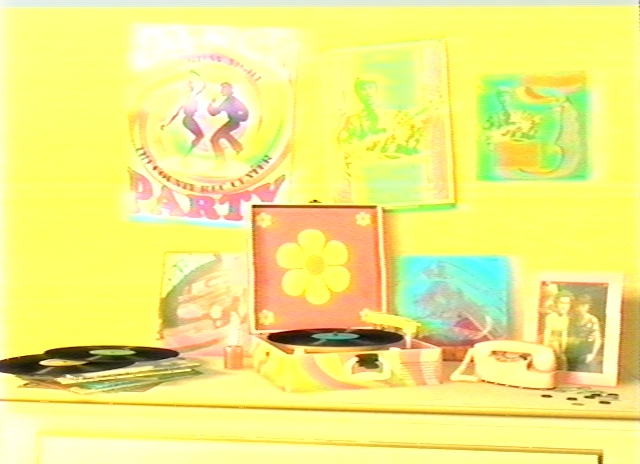
Note the Princess phone in the image above?
It’s sitting to the right of the record player in front of the framed picture.
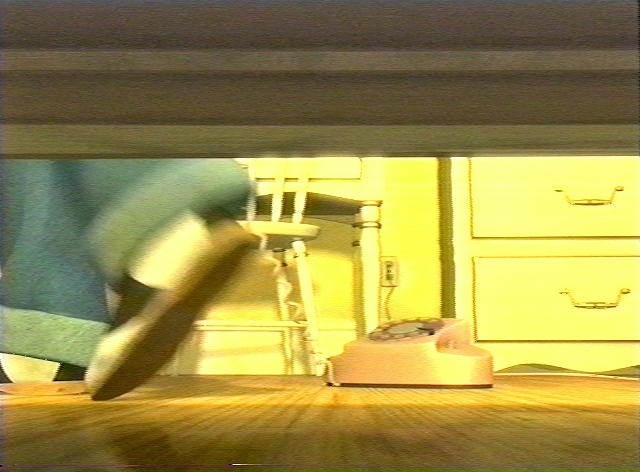
Little girl in “Toy Story 2” animation grows up and gets her own telephone in her bedroom - guess what it was?!! What was the most desired telephone by pre-teen and teenage girls of the 1960’s and 1970’s? The pink Princess, of course!
Movie star Angie Dickinson with Princess telephone.
Click on image to enlarge
Miscellaneous:
Before you proceed to the links below, check out this excellent Princess chart from the book “100 Years of Bell Telephones” by Richard Mountjoy. The chart contains vital information on dates, colors, models and other information for the collector of Princess phones. This chart DOES NOT, however, include the 2702 series of Princess phones which were the touch-tone models.
Click here to view the chart.
Instruction manual that came with the Princess phone. Click here for scan #1 and here for scan #2.
These scans of the Princess instruction manual are from Constantin Maragoudakis.
Bell System Practices document on the 2702 model Princess (touch-tone dial model) in PDF format. Click here to download the file. This file is 1.75Mb so may take time to download.
Bell System Practices document on the 702 model Princess (rotary dial with internal ringer) in PDF format. Click here to download the file.
Bell System Practices schematic for the 701 model (rotary Princess with external bell) can be viewed by clicking here.Bell System Practices assembly drawings on the Princess phone. Click here to view.Here is a Princess phone used in modern advertisement for NetByTel.com. Note the last two sentences where it says, “Now all your customers need is a phone. Any old phone.” Click thumbnail image to view full size:
These scans are from a 1960 Telephone Almanac (click on each image to enlarge):
Has your touch-tone Princess developed an intermittant weak dial-tone when you pick up the receiver? It may just need some contact cleaning on the touch-tone pad. See this photo.Old Bell System advertisements of the Princess phone:
Advertisement #3- Courtesy of Becky Luxbacher - Ebay ID: beccer
Advertisement #4- Courtesy of Mark Yeager - Ebay ID: mjy1
Keychain Princess phone charm" advertising give-away; an original 1959 Bell System Promo:

Real pink Princess phone
Click on image above to enlarge
Real blue Princess phone
compared to keychain Princess
Click on image above to enlarge
Pink keychain Princess “charm” close-up
Click on image above to enlarge
Blue keychain Princess “charm” close-up
Click on image above to enlarge
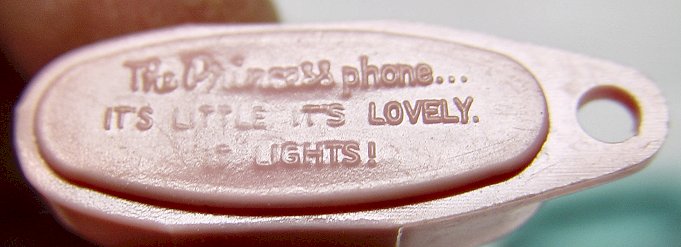
Molded on the bottom of the keychain Princess are the words:
“The Princess phone…It’s Little. It’s Lovely. It Lights!”
Keychain Princess phone charms" shown above were sent to me by logantradingco.com
“Your Online Source for Astounding Collectibles, Antiques, Novelties, Auctions and More!”
“The Transmitter” Cover Story on the PRINCESS* Telephone
(Click on image above for full-size view)
This web page contains some excerpts from the September/October 1960 issue of “The Transmitter”, published for the active and retired employees of The Chesapeake and Potomac Telephone Companies of the Bell System.
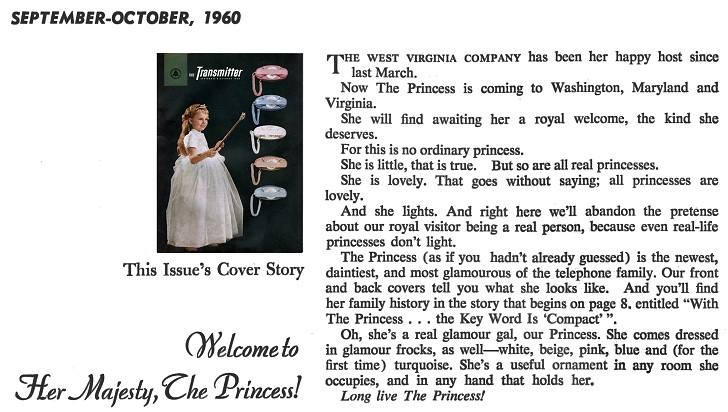
The above scan is of the upper half of the inside front cover and introduces the cover story found on pages 8 and 9 of this magazine.
To maintain a higher quality image of the two-page article so you can still read the words, you will have to scroll your browser’s horizontal and vertical positioning to view the entire article. It will take some time to download if you have a regular dial-up modem of 56K or slower. Some editing of the layout of the two pages was done to make the image (and thus the file) more compact with no loss of information or photos. Basically I edited out the wide white margins and other large white spaces. Please click HERE to view the scan of pages 8 and 9.
I also scanned the back cover of the magazine and you can view it by clicking HERE.
*Princess was a registered trade mark of AT&T.

Word Mark PRINCESS
Goods and Services (CANCELLED) IC 009. US 021. G & S: TELEPHONE SETS. FIRST USE: April 15, 1959. FIRST USE IN COMMERCE: July 6, 1959
Mark Drawing Code (5) WORDS, LETTERS, AND/OR NUMBERS IN STYLIZED FORM
Serial Number 72087107
Filing Date December 11, 1959
Registration Number 0702185
Registration Date August 2, 1960
Owner (REGISTRANT) AMERICAN TELEPHONE AND TELEGRAPH COMPANY CORPORATION NEW YORK 195 BROADWAY NEW YORK NEW YORK
Assignment Recorded ASSIGNMENT RECORDED
Type of Mark TRADEMARK
Register PRINCIPAL
Affidavit Text SECT 15.
Renewal 1ST RENEWAL August 2, 1980
Live/Dead Indicator DEAD
Cancellation Date August 18, 2001



Reliable, secure high-speed internet
With CenturyLink Simply Unlimited Internet, you can choose from a wide range of available speeds that fit your online needs. Plus, you can connect several devices with super-fast in-home WiFi.
Order Now


